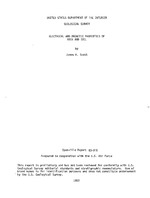Field and laboratory measurements have been made to determine the electrical conductivity, dielectric constant, and magnetic permeability of rock and soil in areas of interest in studies of electromagnetic pulse propagation. Conductivity is determined by making field measurements of apparent resisitivity at very low frequencies (0-20 cps), and interpreting the true resistivity of layers at various depths by curve-matching methods. Interpreted resistivity values are converted to corresponding conductivity values which are assumed to be applicable at 10^2 cps, an assumption which is considered valid because the conductivity of rock and soil is nearly constant at frequencies below 10^2 cps. Conductivity is estimated at higher frequencies (up to 10^6 cps) by using statistical correlations of three parameters obtained from laboratory measurements of rock and soil samples: conductivity at 10^2 cps, frequency and conductivity measured over the range 10^2 to 10^6 cps. Conductivity may also be estimated in this frequency range by using field measurements of water content and correlations of laboratory sample measurements of the three parameters: water content, frequency, and conductivity measured over the range 10^2 to 10^6 cps. This method is less accurate because nonrandom variation of ion concentration in natural pore water introduces error.
Dielectric constant is estimated in a similar manner from field-derived conductivity values applicable at 10^2 cps and statistical correlations of three parameters obtained from laboratory measurements of samples: conductivity measured at 10^2 cps, frequency, and dielectric constant measured over the frequency range 10^2 to 10^6 cps. Dielectric constant may also be estimated from field measurements of water content and correlations of laboratory sample measurements of the three parameters: water content, frequency, and dielectric constant measured from 10^2 to 10^6 cps, but again, this method is less accurate because of variation of ion concentration of pore water.
Special laboratory procedures are used to measure conductivity and dielectric constant of rock and soil samples. Electrode polarization errors are minimized by using an electrode system that is electrochemically reversible-with ions in pore water.


